Interested in employee monitoring?
From startups to large corporations, employee monitoring is increasingly popular among businesses of all sizes. It can include tracking employees’ internet usage, phone calls, physical movements, email, and more.
If done right, tracking employee activity can improve productivity, determine variable pay, and comply with data security requirements.
However, it can also have several negative consequences if done incorrectly — including employee disengagement and even legal liabilities.
In this article, we’ll cover everything about employee monitoring solutions, their applications, benefits, disadvantages, and legal aspects. We’ll also highlight how to choose an employee monitoring tool and implement an employee monitoring system.
This Guide Contains:
(click on the links below to jump to a specific tool)
- Employee Monitoring Solutions
- Employee Monitoring Applications
- Benefits of Employee Monitoring
- Disadvantages of Employee Monitoring
- Legal Aspects of Employee Monitoring
- Choosing An Employee Monitoring Tool
- Implementing An Employee Monitoring System
- Employee Monitoring Resources
Let’s dive in.
Employee monitoring solutions
Here are five ways you can monitor employees during work hours:
1. Video surveillance
Commonly used for workplace surveillance, CCTV cameras help identify unusual employee behavior or potential security issues.
While you can use it to see if employees are at their workstations and ensure workplace security, you can’t gauge their productivity.
However, if you decide to install a video surveillance system, ensure that it’s in common areas and doesn’t directly capture employee computer activity or screen. Otherwise, it could be a violation of workplace privacy.
2. Network and email monitoring
Network and email monitoring is a more direct way of monitoring employees.
Here’s how they help you keep tabs on employees:
- Network Monitoring: monitor infected workstations, malicious programs, and internet usage in a company.
- Email Monitoring: check if employees are using work email addresses to send out personal or malicious emails.
3. Keycards and biometric terminals
Here’s how keycards and biometric terminals can help monitor employees:
- Keycards: Used to restrict employees from entering unauthorized locations within the company building. It can also be used to monitor employee attendance and track employees’ physical location within office premises.
- Biometric Terminals: Used in companies that demand very high-security levels to keep employees out of restricted areas.
4. GPS tracking
This employee monitoring solution helps organizations keep track of employees who are always out on the field.
However, GPS tracking isn’t perfect.
For example, while you can always fit a tracker to a company vehicle to see its real-time location, you can’t always force employees to download location tracking apps on their personal smartphones.
5. Employee monitoring software
Employee productivity tracking and monitoring tools are the most widely used employee monitoring solution. It’s usually the most direct and least invasive method, suitable for both in-office and remote teams.
Most employee monitoring tools offer features like project time tracking, distraction management, and systems to differentiate between work-related and non-work-related activities.
Here’s a detailed guide on employee monitoring solutions.
Employee monitoring applications
Companies might monitor their employees’ work activity for several reasons. Here are the most common applications:
1. Managing remote employees
Remote work is growing at a phenomenal pace among companies of all sizes — mainly due to the COVID pandemic.
Corporate giants like PwC and Manulife and startups like Buffer and ToDoist invest substantially in a remote workforce. In fact, at Time Doctor, our entire team of 100+ employees works remotely from 40 countries across the globe.
Remote work certainly has productive benefits but working from home is also subject to numerous distractions like social media, YouTube, or household chores.
It’s hardly possible for managers to manually keep track of what people working from home are doing. That’s why companies employing remote workers use employee monitoring software like Time Doctor to keep track of their employees’ activities with ease.
2. Customer support quality
Every professionally run contact center records all phone calls with customers — which helps maintain quality and train support agents to improve customer handling skills.
It’s also essential to maintain recordings for legal purposes if there’s ever a customer dispute.
Moreover, contact center tools allow managers to listen in on calls that are in progress. Support agents perform far better when they know that their performance is being closely monitored.
Similarly, there are tools for monitoring chats and email conversations of your support team with customers.
3. Financial services
Financial services companies use employee monitoring for their sales as well as operations. Most of them need to follow stringent information security and confidentiality regulations such as ISO27001, which require them to monitor employees to prevent data leaks or data theft.
Data Loss Prevention (DLP) Solutions help companies detect possible data breaches by monitoring keystroke logging, network traffic monitoring, etc. Most financial companies will also have cameras in the office for monitoring employees.
Several countries make it mandatory for any company selling a financial product such as insurance or mutual funds to record sales conversations. This ensures that agents don’t use questionable tactics or false information to persuade people to purchase.
4. Billing for agencies
Digital marketing, designing, software vendor, and other agencies often bill clients by the hour.
Using a tool like Time Doctor makes it extremely easy to keep track of the quantum of hours dedicated to each project. Billing your clients becomes a breeze, and disagreements about billable hours are practically eliminated.
5. Software projects
Companies employing Agile project management for software development need to understand how they are investing their worktime.
Using an employee time tracking tool integrated with project management tools like Jira can help with productivity monitoring. Project teams can discuss their worktime usage during Scrum meetings and continuously find ways to improve their processes.
6. Sales teams
Companies use a variety of employee monitoring tools to improve sales productivity. Field sales apps such as Badger Maps with GPS tracking can be used to determine if field sales reps take the most time-saving routes while visiting different meeting locations.
Benefits of employee monitoring
Here are some benefits of employee monitoring:
1. Minimize wasting time at work
Wasting time is a common practice in any office, and it’s even more prevalent in a remote setting — where there’s no way for the manager to see what team members are up to.
Any time wasted or idle time at work is a financial loss for your company. That’s why an increasing number of companies use an employee monitoring tool like Time Doctor to minimize time wastage.
Time Doctor tracks employee activity in ways like:
- The timer tracks how long people have been spending at work and on what projects.
- Screen monitoring allows managers to keep tabs on employees’ computer screen activity.
- Website tracking lets you see what websites they are browsing.
2. Minimize supervision and micromanagement
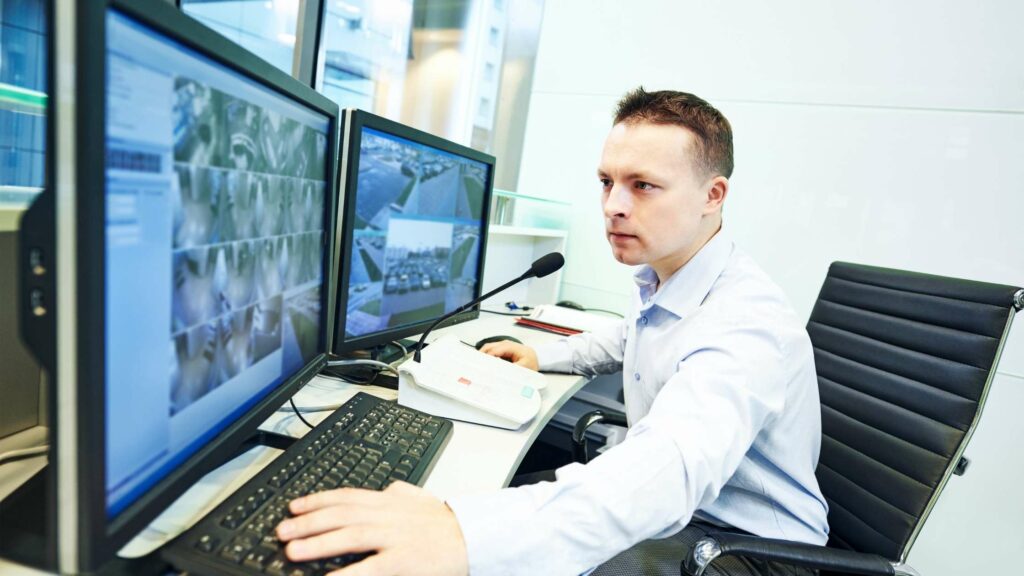
Employee monitoring tools actually help reduce supervision.
Here’s how:
- When employees know they’re being monitored, they’re far less likely to waste their time on non-work related activities.
- Managers will rarely need to ask someone what they are working on at a particular period.
Time Doctor tells you when people are online and exactly which task and project they are working on — in real-time.
Managers can also look at weekly and monthly reports to see what people have been working on and if they’ve been visiting unproductive sites.
Employee monitoring software allows managers to stop wasting time on supervision and invest that time in more value-added activities like planning, strategy, training, and more.
3. Automate routine HR and payroll tasks
Employee monitoring can help drastically reduce routine HR tasks like payroll and attendance tracking of full-time employees and freelancers.
Employee monitoring apps can keep track of attendance, leaves, and hours worked and auto-calculate variable remuneration and salaries.
For example, Time Doctor integrates with payment processing platforms such as Payoneer to disburse salaries and other payments.
This is extremely useful for SMBs which don’t have the resources to hire dedicated HR or payroll managers.
4. Improve management reporting
Some companies use manual timesheets to keep track of hours spent on projects.
However, these records are rarely accurate.
Most employees don’t bother to fill up timesheets because it’s an additional chore that doesn’t add value to their work. Even people who do fill up their timesheets do it from memory, and so records are questionable.
Lack of accurate timesheets can be a major challenge for management reporting in any services company like a marketing agency or an accounting firm.
Here are two examples:
A. Estimate profitability
If you don’t know what projects your people are spending their time on, it’s impossible to calculate how profitable each project or account is correctly.
Consequently, companies might end up spending an excessive amount of time on projects in proportion to the amount of revenue those projects are generating.
Conversely, if companies believe specific projects to be less profitable than they actually are, they might under-invest in them by dedicating fewer employees to those projects. That might affect project quality and lead to client churn.
Using a time tracking tool such as Time Doctor allows companies to monitor employees’ time usage easily and generate automatic timesheets. As a result, you know the profitability of each project and can dedicate resources accurately.
B. More accurate billing
Clients are far less likely to question the authenticity of automated timesheets.
Time Doctor can be used to generate reports that show how many hours have been spent on a project. You can even add clients to the tool so they have direct access to data on how many hours it actually took to complete their project.
5. Assess manpower requirements and allocate work
Usually, it’s difficult to estimate the amount of time it would require to complete a task.
Moreover, there is no clear data in many organizations to indicate exactly how many hours are dedicated by an individual or a team.
When you don’t have clear data, work allocation is based on guesstimates — which is rarely accurate.
An employee monitoring program solves this problem by giving detailed insights into your team’s bandwidth. You can easily reallocate tasks if you see that some employees spend less time while others have too much on their plate.
This makes your entire company more productive by utilizing people’s bandwidth, which increases profitability.
Moreover, distributing work more equally creates a feeling of fairness and transparency that improves overall employee satisfaction.
6. Boost individual productivity
Here are some ways employee monitoring software, like Time Doctor, help make people more productive:
- Gives us a reality check and makes us aware of how much time we are really wasting.
- Helps us see where we’re losing time and take active steps to minimize the time spent on wasteful activities that keep us busy but not productive.
- Lets us keep track if we are spending too long on certain tasks.
- Helps us avoid distractions. For example, if we visit a non-work-related website during work hours, then Time Doctor generates a pop-up asking if we are still working on that task. This prompts us to get back on track.
7. Derive insights from big data analytics
Several companies use big data analytics to derive deeper insights from employee monitoring data.
HR analytics companies use data and metrics to predict:
- Who might be considering a job switch.
- Which work activities lead to great productivity.
- What type of communication channels lead to greater cross-functional collaboration.
With accurate analytics, managers can also follow up with customers to resolve problems and prevent unhappy customers from churning. They can also coach concerned employees to handle similar situations better in the future.
8. Improve employee engagement
An employee monitoring tool increases engagement in several ways, like:
- Minimum supervision: As long as people meet their deliverables and maintain quality standards, managers don’t have to dig through the analytics and reports to check if people are wasting valuable work time on social media.
- Improved productivity: It can guide people to become more productive by revealing their weaknesses.
Additionally, equal allocation of work, automating manual activities, and increased transparency — all lead to higher employee engagement levels.
Disadvantages of employee monitoring

If done wrongly, employee monitoring can negatively impact employee morale and decrease employees’ productivity, engagement, and lead to attrition.
Here’s what can go wrong:
1. Privacy issues
Most people feel that employee monitoring software invades their privacy.
They might not be comfortable with their working hours and web history being logged, screen recording, or screenshots being taken of their screen activity.
Privacy concerns would be higher for people subject to employee monitoring for the first time or in higher positions. That’s why many companies monitor staff selectively. They might monitor remote employees, but not the employees working out of physical offices.
2. Lack of trust
One of the simplest ways of losing people’s trust is not informing them you’re monitoring them. Avoid using computer monitoring software that monitors employee activities stealthily.
If someone finds out they are being monitored stealthily, they can land you in serious legal issues in certain regions — you might even get sued by a disgruntled employee.
Even if you let them know, using intrusive employee monitoring apps, like keystroke logging or keylogging, can severely damage employee engagement. Moreover, it’s also illegal in some states.
3. Legal considerations
Several regions have employee monitoring guidelines and not following them can leave you vulnerable to lawsuits.
A simple way of staying out of trouble is to inform you’re monitoring employee communications and only use tools like Time Doctor that respect privacy rights, are not excessively intrusive, and give a lot of control to the user.
Additionally, keep in mind that certain industries and laws require you to monitor employees — and you can get into trouble for not doing so!
However, you shouldn’t avoid employee monitoring as 99% of employee monitoring is perfectly legal and leads to higher productivity and profitability. As long as you don’t use overly intrusive tools and follow the right process to implement it, you will reap the benefits.
Legal aspects of employee monitoring

It’s essential to take a quick look at a few legal aspects before you begin looking for an employee monitoring software and begin implementing a monitoring policy.
The most important legal aspect of employee monitoring is consent.
For the most part, if your employees consent to be monitored, you can do so.
A few US states such as Connecticut and Delaware prohibits an employer from monitoring without obtaining employee consent. If you have employees working from the EU, you would be subject to the GDPR rules, which have stricter privacy laws than in the US.
You also have federal and state laws that prohibit an employer from monitoring specific activities such as email communication. For example, the US Electronic Communications Privacy Act (ECPA) states that an employer can monitor workplace communications only if they have employee consent.
Remember, avoid using employee tracking software specifically designed to monitor employee activity without their knowledge. Using this kind of software is a criminal offense in several regions and can subject employers to civil lawsuits.
The bottom line
Follow these two principles and you’ll largely be fine:
- Always obtain employee consent for everything you monitor.
- Don’t monitor people outside their working hours.
Choosing an employee monitoring tool
Before you choose an employee monitoring tool, you need to consider several aspects like:
1. Risk assessment and goals
Conduct a risk assessment of your business to understand what exactly you need to monitor. It also helps set definite goals about what workplace monitoring is expected to achieve.
Here are some examples:
A. Compliance and contractual obligations
Industry regulations, guidelines, codes of ethics, confidentiality requirements, or contractual obligations might require you to monitor your employees’ activity.
Not doing so can subject you to liabilities in the form of fines, license cancellations, or lawsuits. A common example in banks and financial services companies is data theft or insider trading — both of which are criminal offenses.
B. Productivity
Here, the risk involves people not meeting deadlines, remote workers running personal errands during work hours, and so on.
C. Quality
Are your employees adhering to quality standards?
This is especially important for teams that are customer facing — like support and sales, or even operations in the case of the hospitality and retail industries.
D. Automation
You might want to deploy a time tracking software only to automate attendance and leave tracking. Even if you don’t have any productivity or quality concerns, it can help eliminate the need to track these aspects manually.
E. Misuse of company resources
This might involve using company resources such as software or equipment for personal purposes. For example, an employee using company software for working on personal freelancing projects.
F. Determine modalities
Once you have determined what aspects you need to monitor, you need to decide the approach you’ll use to monitoring employees.
G. Computer activity and time usage
Computer monitoring is the fastest-growing category which applies to nearly all industries and teams. You would use tools like Time Doctor for time tracking, websites being visited, screen activity tracking, and more.
H. Voice conversations
This includes calls over the phone, VoIP, or any other cloud-based calling system such as Twilio. This is most commonly used in contact centers.
Similarly, you might want to monitor support emails and chat conversations.
I. Video
Most offices have camera surveillance for security purposes and compliance. They are also used in warehouses, factories, retail outlets, etc. for monitoring quality.
2. Determine teams and levels
Want to deploy the monitoring tool for your entire company or just for selected teams, levels, or locations?
People above a certain level tend to be committed to the job and they usually spend large amounts of time away from their desks and in meetings. So it would not be practical to try to track employees’ productivity with time tracking software.
Similarly, you might want to monitor only your remote employees or your field salespeople — because salespeople would hardly be in the office, and more importantly, their compensations are substantially linked to their performance. They make less money if they don’t work!
However, in all the above examples, you could always automate their attendance tracking with the same tool. Remember, always be clear about why you’re using the tool for a specific group of employees!
3. Using Time Doctor to monitor your employees
An excellent employee monitoring tool will have several features that allow it to be used for multiple applications.
And that’s where Time Doctor comes in!
Used by powerhouses like Ericsson and SMBs like Thrive Market, Time Doctor can help you monitor your team and increase business productivity by 22%.
(Try it out for it free for 14 days — no credit card required.)
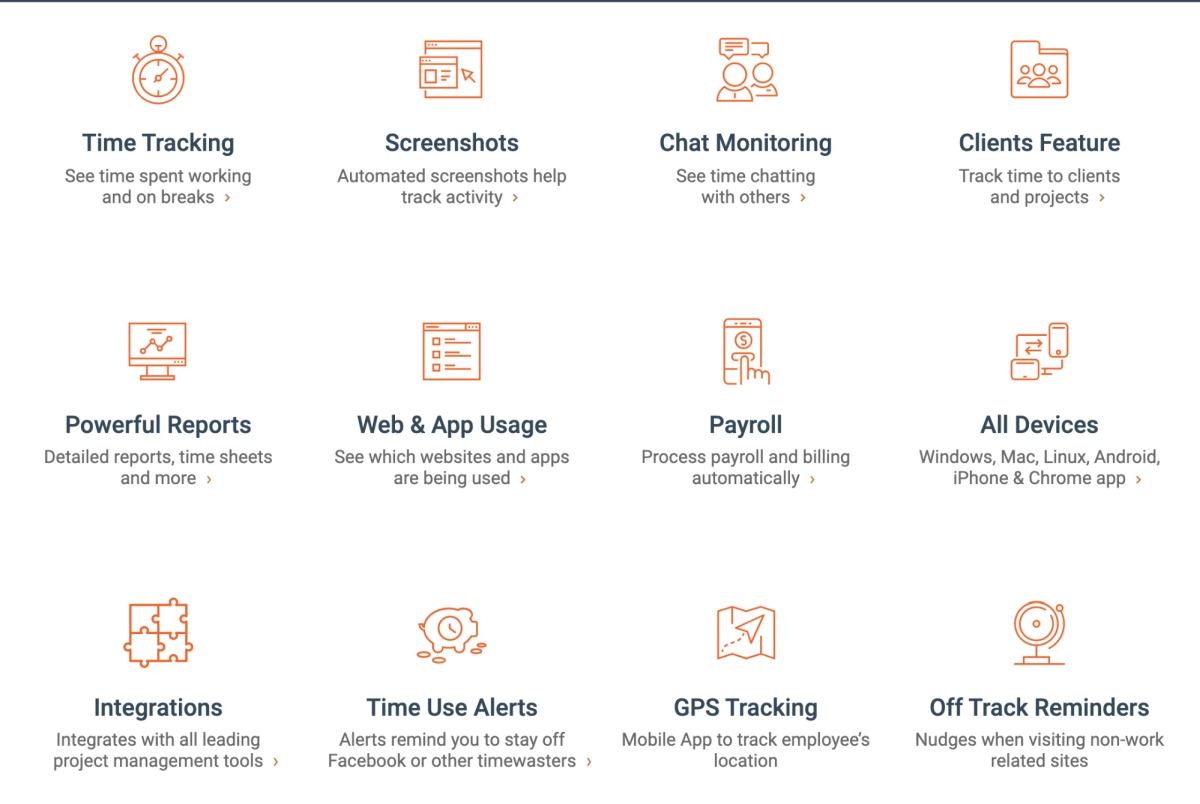
Here are the most important features that make Time Doctor an excellent productivity and monitoring solution:
A. Control with employees
To avoid employee privacy issues, you need to choose a monitoring solution that lets your employees decide when their computer activity is being monitored.
If you use a stealth employee tracking tool, it can be challenging to convince them you’re not tracking their personal activities. This can damage the relationship with your employees.
However, Time Doctor doesn’t track your computer activity all the time — only when you click on the start button on a particular task. Once you click on the start button, the task timer and all other features start running.
This way, Time Doctor gives users complete control over what’s being tracked and when.
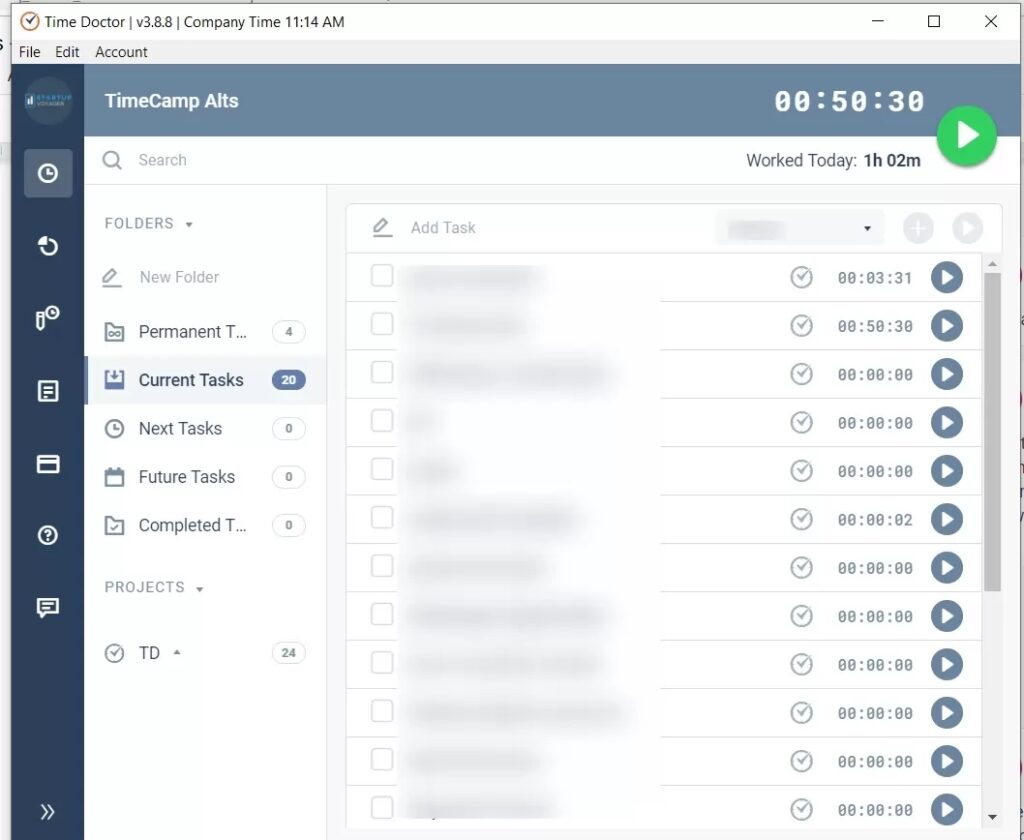
B. Tracking inactivity
Time Doctor uses mouse and keyboard activity to determine if people are still working.
This is similar to the inactivity function on your computer — if it does not detect user activity after a few minutes, your computer will go to sleep.
Note: Time Doctor doesn’t record your keystroke or identify which keys you’re pressing to protect user privacy.
C. Project tracking
At the end of the week, it’s a great idea to go through which projects your people have worked on and how much time they have dedicated to it. For that, you need detailed reports.
In Time Doctor, here are a few applications of these reports:
- Check if people are spending excessive time on any projects.
- Calculate the total billable hours on a project.
- Check all the tasks an employee has worked on during the week.
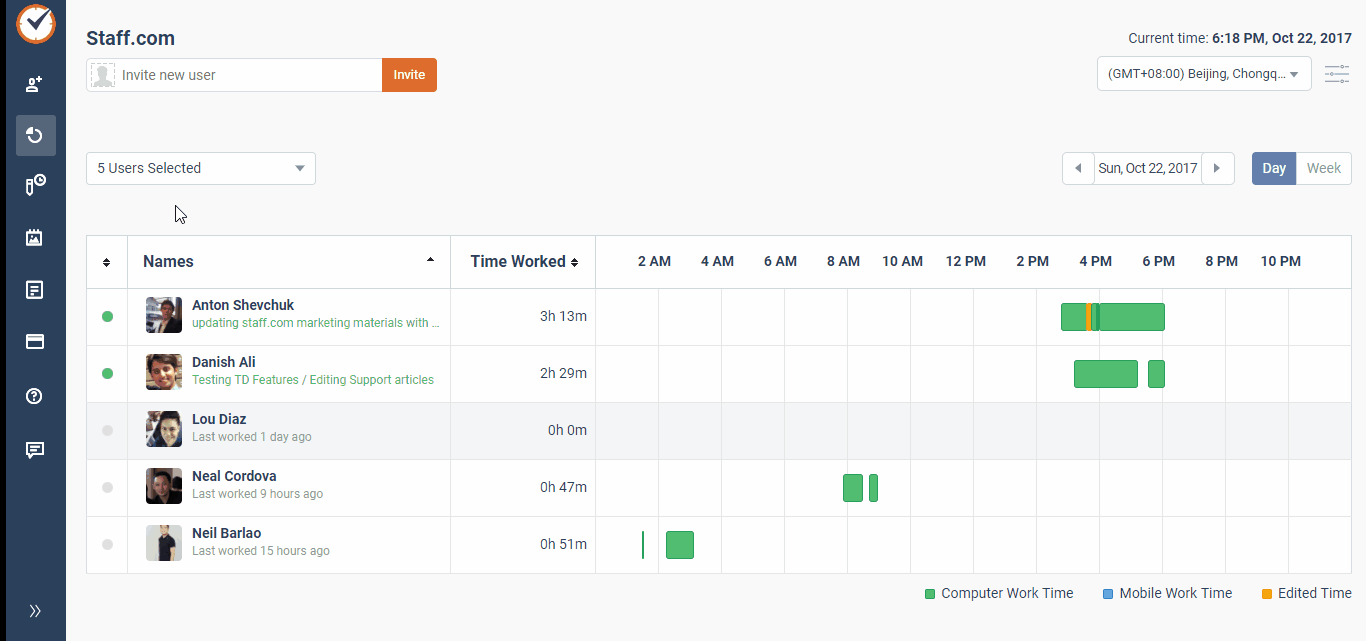
D. Website and application monitoring
The time tracking functionality will let you know how many hours have been logged working on tasks and projects. But how productively were those hours used?
Were your employees actually working on tasks or were they watching Netflix with the timer running?
That’s why your employee monitoring tool needs to keep track of what websites your employees have been visiting and the applications they have been running, and for how long.
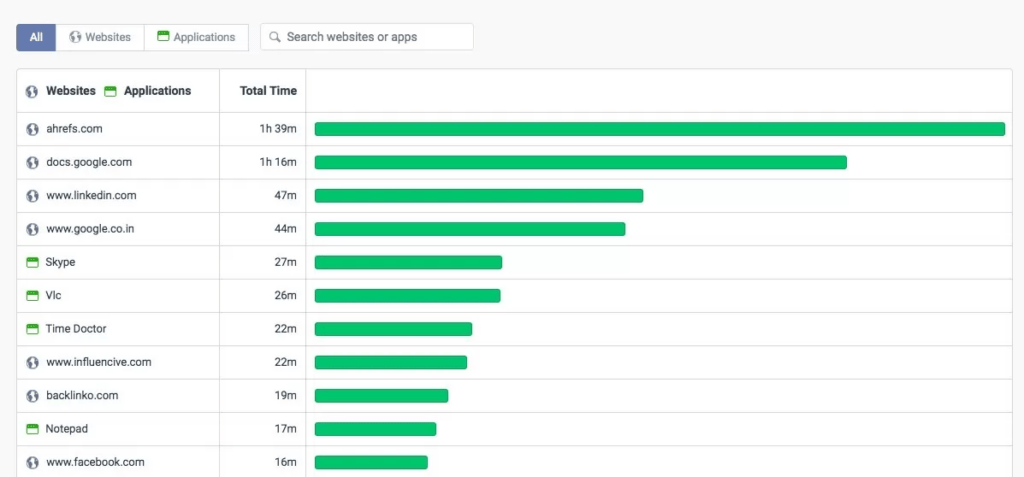
With Time Doctor, you can view a Web and App Usage Report, which will have details of all the sites and apps each worker has visited over a selected period and for how long.
This remote employee monitoring software also shows you a ‘Poor Time Use’ report, that contains a list of potentially unproductive websites that each worker has been visiting.
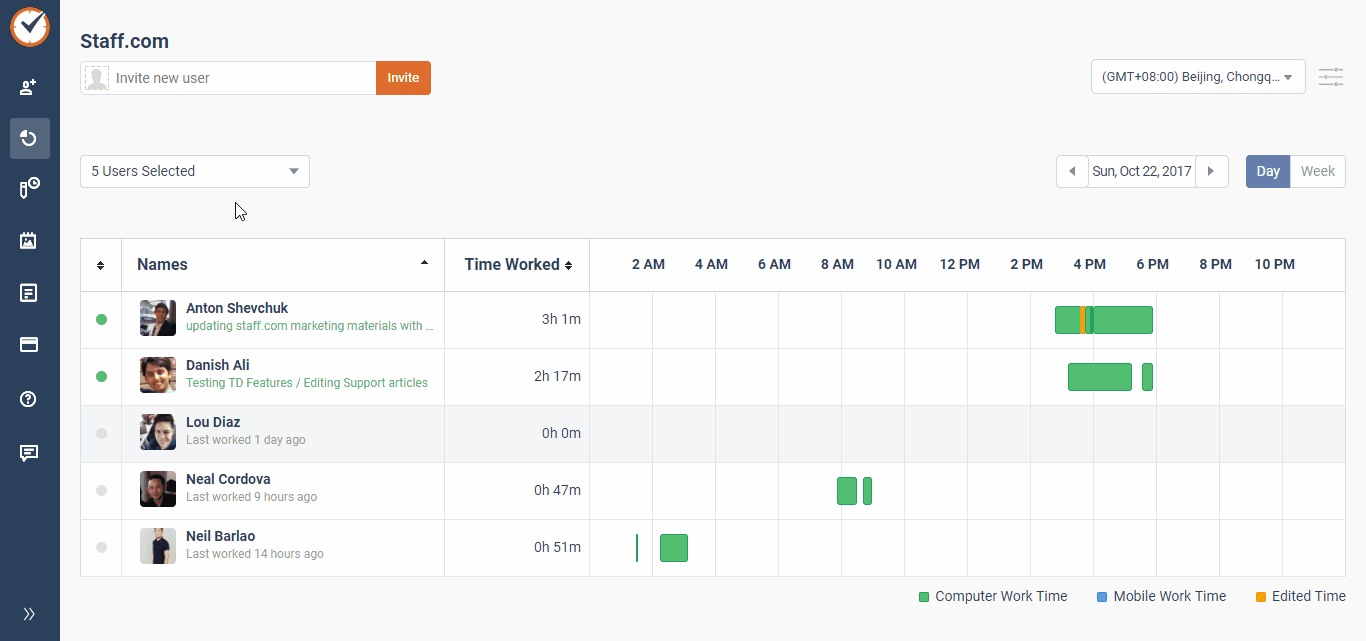
E. Avoiding distractions
Time Doctor has a monitoring feature that generates a pop-up whenever someone visits a potentially distracting website or application in the middle of a task while the task timer is running. The pop-up asks if you’re still working on that task and you can choose Yes or No.
This nudge is sufficient for most people to either not visit that website at all or spend a minimal amount of time on it during work hours.
F. Integrations
Your tool should ideally integrate with other workplace tools to maximize its utility.
Time Doctor integrates with different types of software to help automatically track time being spent on different tools.
Some of these integrations are:
- Project management: Asana, Jira, Trello, Basecamp.
- Customer Support Tools: Zendesk, Freshdesk.
- CRMs: Salesforce, Zoho integrations.
- Communication Tools: Slack, Google Calendar.
- Accounting: Freshbooks.
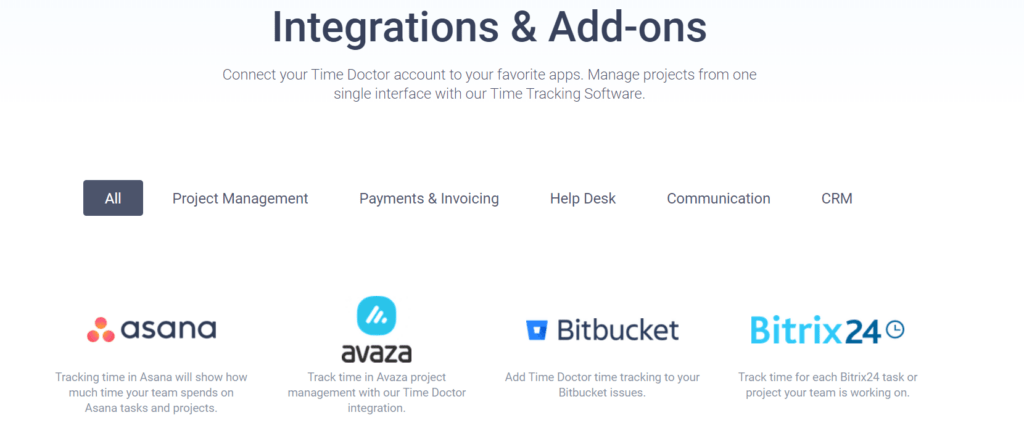
Time Doctor also integrates with Zapier, helping you connect it to practically every software you’re using.
Implementing an employee monitoring system
It’s important to follow a structured process for implementing an employee monitoring system. This helps gain your employees’ cooperation and gets them to view it as a positive development.
Here are some steps you might want to follow:
1. Document an employee monitoring policy
Before you begin to implement anything, it’s best to draft an employee monitoring policy document which serves two purposes:
- Have clear guidelines about what you would be monitoring.
- Inform employees about those guidelines.
Your employee monitoring policy document should specify the following:
A. Goals
What would the company like to achieve through monitoring? What risks is the company trying to prevent?
B. Benefits to employees
How will monitoring employees help them?
C. Scope
What will you monitor— computer activity, calls, emails? What sort of information will be collected, how will your company use it, who has access to it, and how long will that information be stored?
D. Who
Who will you monitor? A remote employee only or an entire team?
E. Tools
What tools will you use to monitor people?
F. Legal or contractual obligations
Mention if you’re monitoring your people because of legal or contractual requirements — and what those requirements are.
G. Examples
Provide a few examples of how the monitoring will take place to help your employees have a clearer idea.
H. Actions
What should employees do to implement and support the policy?
I. Questions and feedback
Make your policy as clear as possible and free of unnecessary legal jargon.
If people can’t understand your policy without racking their brains, they’ll assume you’re trying to mislead them. That is bound to put them on their guard.
Check out our sample employee monitoring policy template.
2. Phased roll-out
Rather than implementing employee monitoring at one go, start by rolling it out in phases.
This is perfectly normal for large or mid-sized companies, but even if you have over 50 employees, rolling it out in phases would help you understand the tool better.
For example, you might decide to implement a remote employee monitoring system for your tech team first. Based on the observations and feedback, you can adapt your policy document and roll it out for other teams.
The initial pilot will give your managers and HR team valuable data about work patterns and make them familiar with the tool. This will make it easier for them to answer questions that employees could ask in the subsequent phases.
3. Add it to the employment contract
Remember, it’s essential to have your employees’ consent before you begin to monitor them.
That’s why it should be part of their employment contract.
The contract should stipulate that all activity monitoring will be done according to the guidelines and methods mentioned in the monitoring policy.
You can create an addendum to their current contract for your existing employees, which everyone would sign. For all newly joining employees, simply add a clause to their employment contract.
4. Explain the objectives and benefits
Your people might consent to be monitored, but that doesn’t mean they’ll be fully comfortable with it. So you should clearly explain how they will gain from the initiative.
Don’t just surprise people by emailing them the policy!
Instead, hold a town hall where you explain everything your employees would want to know. Take your people through a presentation of the monitoring policy.
If you’re implementing a phased roll-out, mention the pilot team’s experiences and the benefits gained from the monitoring.
Here are some key benefits to employees that you should highlight:
A. More autonomy
Bosses will check up on their employees far less often and will only be looking at their output.
B. Improved productivity
The tool will show them exactly where their time is being wasted during the workday. That will help them to modify their work habits and become more productive.
C. Respect for employee privacy
Highlight the fact that you’re not tracking their personal time.
If they use Time Doctor, they can even stop the timer in the middle of the workday to run a personal errand. As long as they make up those extra few minutes later on during the workday, why will anyone complain?
D. More transparency
The time tracking reports will clearly indicate what tasks people worked on and for how long.
No one will be unjustly told again that they aren’t putting in the requisite hours, wasting their time, or not doing their best.
E. Penalize people who are shirking
The most damaging people on the team are the ones who shirk their work.
People who don’t contribute enough to the team are bad for the entire team’s motivation and productivity — and honestly, no one likes them. An employee monitoring system will be able to identify those people quickly. They can be coached, or if necessary, replaced.
F. More recognition
Employee monitoring software will also indicate which people are working longer and identify those who are evidently hanging around in the office longer but spend most of their time in the cafeteria! Recognition will be given more fairly.
G. Automated reports
No one will have to fill up a timesheet ever again!
People can stop wasting time on such administrative tasks.
5. Train your people
It’s best to train your people to use the software.
While tools like Time Doctor are extremely simple to use and don’t really require training, taking your people through the software will make them open up and become more comfortable.
If you choose Time Doctor, we’ll be happy to deliver training for your employees and answer any questions they have.
Have people across multiple offices or remote employees?
Host a webinar and take your colleagues through the tool. It might be a good idea to record the webinar so that future employees can check it out.
6. Gather feedback
Feedback plays a vital role in the success of your employee monitoring system for two reasons:
- A simple way to drive the employee monitoring tool’s adoption is to involve people in the decision-making process. Just by listening to their viewpoints, you make them far more comfortable with being monitored. They begin to trust you a lot more.
- The people using the tool will give you genuine insights about how to make the system more effective.
However, feedback isn’t a one-time thing.
Instead, take it at various stages of implementation and over several interactions, like:
- During the monitoring policy presentation.
- A few weeks after people have been using the system through anonymous forms.
- During weekly conversations with managers.
- During employee performance appraisals.
Employee monitoring resources
Check out these articles if you want to learn more about employee monitoring:
- Pros and Cons of Employee Monitoring: Does It Increase Productivity?
- How to Maintain Employee Monitoring Ethics at Work
- How To Monitor Employee Facebook Usage At Work: A Practical Guide
- Here’s Why the Way You’re Tracking Employee Hours Doesn’t Work
Wrapping up
Employee monitoring has the potential to substantially improve your company’s productivity and quality standards in several ways — and so, it has a direct impact on your profitability.
Follow the recommendations I have shared in this article and you can also increase autonomy and employee engagement.
So why not sign up for a free trial of Time Doctor and monitor your employees the right way?

Andy is a technology & marketing leader who has delivered award-winning and world-first experiences.


